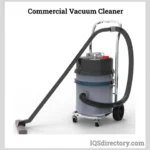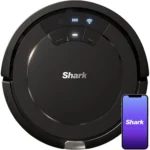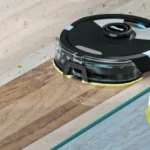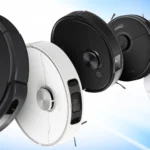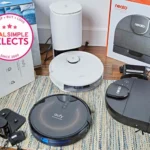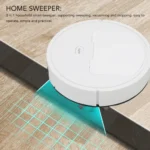Are you tired of struggling with an outdated and ineffective vacuum cleaner that fails to meet your cleaning needs? The solution may be as simple as choosing the right canister vacuum cleaner for your home. Canister vacuums are versatile, lightweight, and offer excellent maneuverability, making them a popular choice for modern households. However, with so many options available in the market, choosing the perfect one can be perplexing. In this article, we will guide you step-by-step through the essential factors and features to consider when selecting the best canister vacuum cleaner for your home. So, let’s dive in!
Benefits of Canister Vacuums

If you’re in the market for a new vacuum cleaner, a canister vacuum might be the perfect choice for your home. Canister vacuums are versatile and offer unique benefits that make them stand out from other types of vacuums. One of the main advantages of a canister vacuum is their ability to clean various surfaces, including hardwood floors, carpets, upholstery, and stairs. Additionally, they often have superior suction power and filtration systems compared to other types of vacuums. In this section, we’ll explore the benefits of canister vacuums in more detail to help you determine if they’re the right choice for your household cleaning needs.
Floors
When it comes to cleaning floors with a canister vacuum, one of the most important factors to consider is the type of flooring you have. Different floors require different types of cleaning, and there are canister vacuums designed for each type. Here are some examples of what to look for:
Hardwood Floors: If you have hardwood floors, you want a canister vacuum with a soft brush roll or special hardwood floor attachment. These features will help prevent scratches and other damage to your floors. Additionally, a vacuum with adjustable suction can help customize the cleaning power to your specific floors.
Carpet: For carpet, you’ll want a canister vacuum with strong suction power to lift and remove dirt, dust, and debris from deep within your carpets. Look for models with a motorized brush roll to effectively clean the fibers and remove pet hair.
Tile and Linoleum: For tile and linoleum floors, you’ll want a canister vacuum with a hard floor tool that is gentle enough to avoid scratching but strong enough to pick up dirt and debris. Models with adjustable suction are also ideal for these types of surfaces.
All Floors: If you have a variety of floor types in your home, a multi-floor canister vacuum may be the best choice for you. These vacuums usually come with a variety of attachments to accommodate different flooring types, so you can easily switch between them.
Having the right canister vacuum for your floors can make a huge difference in the effectiveness of your cleaning routine. Take some time to assess your flooring and choose the vacuum that will best suit your needs. To learn more about how canister vacuums work, check out our page on canister vacuum cleaners.
Stairs and Upholstery
When it comes to cleaning stairs and upholstery, canister vacuums are the way to go. These types of vacuums are known for their versatility and maneuverability, making it easy to clean tight spaces and hard-to-reach areas. Here are some important factors to consider when choosing a canister vacuum for cleaning stairs and upholstery:
Suction Power: Look for a canister vacuum with strong suction power to effectively pick up dirt, debris, and pet hair from stairs and upholstery. The best vacuums for these tasks will be able to adjust the suction power according to the surface being cleaned.
Filtration System: A good filtration system is essential when it comes to cleaning stairs and upholstery, as they tend to harbor a lot of dust and allergens. HEPA filters are highly recommended as they are designed to trap microscopic particles, making the air inside your home cleaner and healthier for everyone.
Attachments and Accessories: The right attachments and accessories can make the task of cleaning stairs and upholstery much easier. Look for a canister vacuum with a crevice tool to clean tight spaces, an upholstery tool to clean furniture, and a dusting brush to clean delicate surfaces.
Cord Length and Hose Flexibility: When cleaning stairs or upholstery, a longer hose and cord can be very helpful. Make sure the cord is long enough to reach all the way up the stairs without the need for an extension cord, and that the hose is flexible enough to easily maneuver around furniture and other obstacles.
Compact and Lightweight: Opt for a canister vacuum that is compact and lightweight, making it easy to carry up and down the stairs or move from room to room. This will help reduce the strain on your back and prevent fatigue during cleaning.
When choosing a canister vacuum for stairs and upholstery, look for strong suction power, an effective filtration system, useful attachments and accessories, a long cord and flexible hose, and a compact and lightweight design. For more information on factors to consider when choosing a canister vacuum, check out our comprehensive guide on canister vacuum buying factors.
Pet Hair
Pet hair can be one of the biggest challenges for a vacuum cleaner, especially if you have a furry friend at home. When choosing a canister vacuum, it’s essential to consider the capabilities of the model in terms of dealing with pet hair. Here are some factors to keep in mind:
- Suction Power: Look for a vacuum with powerful suction that can easily pick up pet hair from carpets, rugs, and upholstery. A motorized brush roll can also help loosen and lift hair from surfaces. Models with adjustable suction control can also be handy for dealing with delicate fabrics.
- Filtration System: Pet hair can contain dander and allergens, so it’s important to have a high-quality filtration system that captures these particles. Canister vacuums with HEPA filters are a great choice for pet owners, as they can capture up to 99.97% of dust, pollen, and other allergens.
- Attachments: A variety of attachments can also make a big difference in tackling pet hair. Look for models that come with a motorized pet hair tool or a crevice tool to reach tight spaces. A turbo brush can also be helpful for removing hair from furniture and stairs.
- Noise Level: If you have a skittish pet, you may want to consider a quieter canister vacuum to avoid scaring them. Look for models with insulation or noise-reducing features to keep noise to a minimum.
Keep in mind that even the best canister vacuum for pet hair requires proper maintenance to keep it working effectively. Regularly cleaning and replacing filters, as well as emptying or replacing bags, can help you get the most out of your vacuum. For more canister vacuum maintenance tips, check out our article on canister vacuum maintenance.
Factors to Consider
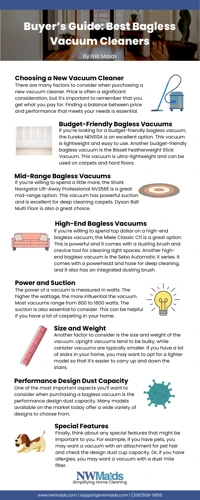
When it comes to choosing a canister vacuum cleaner, there are several factors to consider that can impact your cleaning experience. From suction power to filtration systems, the right features can make a huge difference. Additionally, understanding the various types of canister vacuums available can help you match the right model to your cleaning needs. Before diving into the specifics, take a moment to consider why a canister vacuum might be the best choice for your home cleaning needs. To learn more about the benefits of canister vacuums, check out this article on the top 5 reasons to choose a canister vacuum.
Suction Power
One of the most important factors to consider when choosing a canister vacuum cleaner is the suction power. It determines the strength of the vacuum’s ability to pull dust and debris from your floors and surfaces. It’s important to note that suction power is measured in amps, and higher amps don’t always mean more suction power. There are a few different factors that contribute to the suction power of a canister vacuum.
Motor Strength: The motor is the main component that drives suction power in a canister vacuum cleaner. A more powerful motor means more suction power. Look for a canister vacuum with a motor that has at least 10-12 amps.
Vacuum Head: The vacuum head is the part of the canister vacuum that comes into contact with the floor. The head should make a tight seal with the floor to create a powerful suction. Look for a vacuum head with a wide cleaning path and adjustable height settings to allow for different types of flooring.
Hose and Wand: The length and thickness of the hose and wand also play a role in the suction power. The thicker and shorter the hose, the more suction power the vacuum will have. A longer hose and wand can be convenient for cleaning hard-to-reach areas, but can decrease the suction power.
When choosing a canister vacuum cleaner, it’s important to consider the suction power based on your specific needs. If you have mostly hardwood floors, a lower suction power may be sufficient. However, if you have deep pile carpets, a higher suction power is necessary. Keep in mind that more suction power also means more noise, so if you prefer a quieter vacuum, you may need to compromise on suction power.
For more information on canister vacuums, check out our related articles on canister vacuums for hardwood floors, canister vs. upright vacuums, HEPA filters in canister vacuums, and attachments for canister vacuums. Additionally, read our article about the advantages and disadvantages of bagged vs. bagless vacuums.
Filtration System
When it comes to choosing the right canister vacuum cleaner for your home, the filtration system is an important factor to consider. It determines the efficiency of the vacuum cleaner in capturing small particles, such as dust, pollen, and pet dander. A good filtration system not only improves the air quality in your home but it also prevents allergies and asthma symptoms.
One of the most common types of filtration systems in canister vacuums is the HEPA filter. HEPA stands for High-Efficiency Particulate Air and these filters are designed to capture 99.97% of particles as small as 0.3 microns. This makes HEPA filters ideal for those with allergies, asthma, or other respiratory conditions. Some canister vacuums may have multiple HEPA filters for enhanced filtration.
Charcoal filters are another type of filtration system found in some canister vacuums. These filters are designed to absorb odors, such as smoke or pet smells, while they clean. They work by trapping the odor molecules in the tiny pores of the charcoal, thus improving the air quality in your home.
Another type of filtration system you may encounter is the bagged vs bagless option. Bagged canisters use disposable bags to capture dirt and allergens, whereas bagless models use a cyclonic system to separate the dirt from the air. Both options have their pros and cons, so it’s up to you to decide which one is the right fit for your needs.
Some canister vacuums may also have additional filtration features such as microfiber filters or UV-C sanitizing technology. Microfiber filters are designed to capture smaller particles than traditional filters, while UV-C sanitizing technology uses ultraviolet light to kill bacteria and viruses on surfaces and in the air.
Here’s a table summarizing the different types of filtration systems you may encounter in canister vacuums:
| Filtration System Type | Description |
|---|---|
| HEPA Filters | Captures 99.97% of particles as small as 0.3 microns |
| Charcoal Filters | Traps odors, such as smoke or pet smells |
| Bagged vs Bagless | Bagged models use disposable bags, while bagless models use a cyclonic system to separate dirt from air |
| Microfiber Filters | Captures smaller particles than traditional filters |
| UV-C Sanitizing Technology | Uses ultraviolet light to kill bacteria and viruses |
Choosing the right filtration system for your canister vacuum is crucial for maintaining good air quality in your home. Take your time to research the different options and consider your specific needs, preferences, and concerns. By doing so, you’ll be one step closer to finding the perfect canister vacuum cleaner for you and your family.
Bagged or Bagless
When it comes to choosing a canister vacuum, one of the key decisions you’ll need to make is whether to go with a bagged or bagless model. Both styles have their advantages, so it’s important to understand the differences to choose the one that’s right for your needs.
Bagged vacuums use disposable bags to collect dirt and debris. They tend to be less messy than bagless vacuums, since the bag captures all of the dirt, dust, and allergens during the cleaning process. Additionally, bags usually hold more debris than bagless canisters before needing to be replaced. This makes them an ideal choice for homes with larger families or those with pets that shed a lot.
Bagless vacuums, on the other hand, use a dustbin or canister to collect debris. They typically have some form of filter to capture particles, but they require more maintenance since these filters need to be washed or replaced periodically. While bagless vacuums can be more environmentally friendly, since they don’t require disposable bags, they can be messier to empty and may even trigger allergies or asthma in some people.
So, which is better for you? Well, that depends on your specific needs and preferences. If you want a more low-maintenance option that can hold a lot of debris before needing to be emptied, a bagged vacuum may be the way to go. However, if you prefer a more eco-friendly vacuum that requires more upkeep, a bagless model may be ideal.
It’s also important to note that some bagless models can be more expensive upfront, but save you money in the long run since you don’t have to purchase bags. Bagged models, while typically cheaper upfront, require you to purchase bags on an ongoing basis. Consider your budget and long-term needs when deciding between a bagged or bagless vacuum.
Noise Level
When it comes to selecting a canister vacuum cleaner, the noise level is an important factor to consider. No one wants to deal with a vacuum cleaner that is too loud – it can be disruptive to others in the household and even lead to hearing damage over time. Here are some tips to keep in mind when it comes to noise level:
- Check decibel levels: Most canister vacuums have a noise output ranging from 60 to 80 decibels. A decibel level of 60 is a little louder than a typical conversation, and 80 is about as loud as a garbage disposal. Look for vacuums with lower decibel levels to keep noise to a minimum.
- Look for insulated motors: Some models feature sound insulation around the motor, which can help reduce noise. This is especially beneficial if the vacuum will be used in a smaller space.
- Consider using ear protection: If you do choose a vacuum with a higher noise output, consider using earplugs or headphones to protect your hearing.
- Read reviews: Don’t rely solely on the manufacturer’s noise level claim. Read reviews from other customers to see how they rate the noise level of the vacuum.
When all is said and done, selecting a vacuum with a lower decibel level is always the best choice. By taking the time to research and choose a quiet canister vacuum, you can keep your space clean without creating too much noise.
Cord Length and Hose Flexibility
When it comes to choosing a canister vacuum cleaner, cord length and hose flexibility are two important factors to consider. These features influence the ease and convenience of cleaning your home, especially if you have a larger space or multiple floors.
The cord length determines how far you can move the vacuum around without having to switch outlets. Look for a cord that is long enough to reach every corner of your space without having to unplug and re-plug the vacuum. A good cord length is typically a minimum of 20 feet, but some models have cords that are up to 30 feet long.
The flexibility of the hose is also an important factor. A flexible hose makes it easier to move the vacuum around furniture or other obstacles while cleaning, and it allows you to reach underneath tight spaces like sofas or beds to get rid of dust and debris.
To help you compare the cord length and hose flexibility of different models, we’ve created the following table:
| Model | Cord Length | Hose Flexibility |
|---|---|---|
| Model A | 20 feet | Flexible hose with 360-degree rotation |
| Model B | 25 feet | Flexible hose with 180-degree rotation |
| Model C | 30 feet | Flexible hose with 360-degree rotation and extendable wand |
Remember to consider your specific cleaning needs when choosing a canister vacuum. If you have a large home, a longer cord and more flexibility in the hose may be necessary. However, if you only plan to use the vacuum for smaller cleaning tasks, a shorter cord and less hose flexibility may suffice.
Types of Canister Vacuums
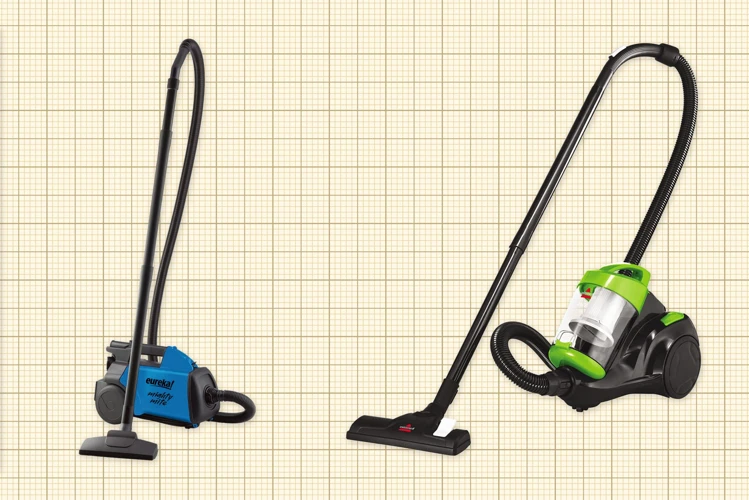
As you dive deeper into the world of canister vacuums, you’ll find that there are various types to choose from. Each model can cater to different needs and preferences, so it’s crucial to find out which one suits you the best. Whether you prefer a versatile multi-floor vacuum, a compact and lightweight one, or a quiet model that won’t disturb your peaceful home, there is something for everyone. Let’s explore these different types in more detail!
Multi-Floor Models
When it comes to canister vacuum cleaners, multi-floor models have become increasingly popular due to their versatility. These models are designed to clean different floors with different surfaces, such as carpets and hard floors. They are equipped with strong enough suction power to clean carpets effectively and are gentle enough to clean hard floors without causing scratches or damage.
Here are some features to look for in a multi-floor canister vacuum cleaner:
- Height adjustment: This feature will allow you to adjust the height of the cleaning head to better suit different surfaces, ensuring that it can pick up dirt and debris without damaging the floor.
- Brushroll on/off switch: This feature is especially important if you have hardwood or other delicate flooring. The brushroll can scratch or damage these surfaces, so being able to turn it off when necessary is crucial.
- Large-capacity dustbin or bag: Multi-floor vacuum cleaners will need to have a larger dustbin or bag, as they will be required to pick up and hold more dirt than other models. A larger dustbin or bag means less frequent emptying, which can save time and effort.
- Adjustable suction: Being able to adjust the suction power of the vacuum is a must-have feature for multi-floor models. This allows you to clean delicate surfaces with less power and to get deeper into carpets with more power.
- Compact and lightweight design: Multi-floor models should be easy to move and should come with a long power cord, so you can easily move around the house without unplugging it.
When choosing a multi-floor canister vacuum cleaner, make sure to pay attention to the above features, as they will contribute to the overall effectiveness and efficiency of the vacuum cleaner. These features will ensure that you get the most out of your vacuum and help you achieve a clean home on any surface.
Quiet Models
When choosing a canister vacuum cleaner, noise level is an important consideration to keep in mind, especially if you have neighbors or live in an apartment complex. Quiet models are designed to operate at a lower decibel level without sacrificing suction power.
Some of the quietest canister vacuums on the market have a decibel range of 60-65, which is around the same level as a normal conversation. These models use insulated motors and noise-reducing materials to minimize sound output.
Here is a table that compares the noise levels of popular canister vacuum models:
| Model | Decibel Range |
| — | — |
| Miele Complete C3 Marin | 56-73 |
| Dyson Cinetic Big Ball Animal + Allergy | 70 |
| Shark Apex DuoClean | 70 |
| Kenmore Elite Canister Vacuum | 67 |
| Eureka Mighty Mite | 79 |
As you can see, the quietest model in this comparison is the Miele Complete C3 Marin with a decibel range of 56-73. However, it’s important to note that the decibel range may vary depending on the type of surface being cleaned and the power setting being used.
When considering a quiet model, it’s also important to look for other features such as suction power and filtration that fit your cleaning needs. Fortunately, many quiet models also come equipped with advanced features such as HEPA filtration and adjustable suction power.
If you’re looking for a canister vacuum cleaner that won’t disturb your household or your neighbors, a quiet model may be the right choice for you. Just make sure to consider other features as well to ensure you’re getting the best cleaning experience possible.
Bagless Models
When it comes to choosing the right canister vacuum cleaner for your home, one of the options to consider is a bagless model. Bagless vacuums are becoming more popular due to their convenience and cost-saving benefits. Let’s take a closer look at the advantages and disadvantages of bagless models.
Advantages of Bagless Models
One of the main benefits of a bagless canister vacuum cleaner is that you don’t need to keep buying replacement bags. This can save you money in the long run, especially if you have a large home or use your vacuum frequently. Additionally, bagless models are environmentally friendly because they don’t contribute to landfill waste.
Disadvantages of Bagless Models
While bagless vacuums have many advantages, there are also some drawbacks to consider. One potential downside is that they require more maintenance than bagged models. You’ll need to regularly empty the dustbin and clean the filters to ensure optimal performance. Another drawback is that bagless models can be messier to empty, as dust and debris may fly out as you remove the canister.
Is a Bagless Model Right for You?
Whether a bagless canister vacuum cleaner is the right choice for you depends on your specific cleaning needs and preferences. If you’re looking for a cost-effective and environmentally friendly option, a bagless model may be ideal. However, if you have allergies or are sensitive to dust, you may want to consider a bagged model with a high-quality filtration system.
Here’s a summary of the advantages and disadvantages of bagless models:
| Advantages | Disadvantages |
|---|---|
| – No need to buy replacement bags – Environmentally friendly |
– Require more maintenance – Messier to empty |
Compact and Lightweight Models
When it comes to choosing the right canister vacuum cleaner, a compact and lightweight model may be the ideal choice for those who have limited storage space or want a vacuum that is easy to carry around their home. Here are some features to look for when considering compact and lightweight models:
- Size and Weight: The first thing to consider when looking for a compact and lightweight canister vacuum is its size and weight. Look for a vacuum that is small enough to store in a closet or under a table, and also light enough to carry up and down stairs.
- Power: Just because a vacuum cleaner is compact and lightweight does not mean it should compromise on suction power. Look for a model that has a powerful motor and strong suction to pick up dirt and debris from your floors.
- Filtration: A good filtration system is essential for any vacuum cleaner, and this is no different for compact and lightweight models. Look for a vacuum that has a high-quality filtration system to trap dirt and dust particles, and to prevent them from being released back into the air.
- Attachments: When looking for a compact and lightweight canister vacuum, it is important to consider the types of attachments that come with the vacuum. Look for a model that has multiple attachments to clean different surfaces and get into tight spaces.
- Noise Level: If you are looking for a vacuum that is quiet and won’t disturb you or your family, be sure to look for a model that has a low noise level.
Compact and lightweight canister vacuums are ideal for those with limited storage space, or for those who want a vacuum that is easy to carry around their home. By considering essential features such as size and weight, power, filtration, attachments, and noise level you are sure to find a model that is perfect for your needs.
Additional Features to Consider
As you continue your search for the perfect canister vacuum cleaner, don’t forget to explore some additional, often-overlooked features that can enhance your cleaning experience. These under-the-radar features can make a significant difference in how you use and enjoy your vacuum. From adjustable suction to retractable cords, these features might not be at the top of your priority list, but they’re definitely worth considering. So let’s dive into these often-ignored features and learn how they can make cleaning more efficient and enjoyable.
Attachments and Accessories
When looking for a canister vacuum cleaner, it’s important to consider what attachments and accessories come with the unit. These can greatly increase the vacuum’s versatility and efficiency. Here are some attachments and accessories you might want to look for:
- Crevice tool: This long, narrow attachment is great for getting into tight spaces, like between couch cushions or along baseboards.
- Dusting brush: This soft-bristled brush is perfect for gently removing dust and debris from delicate surfaces like lampshades, curtains, and upholstery.
- Upholstery tool: This tool has a wide, flat suction head and is perfect for removing pet hair and debris from furniture and mattresses.
- Pet hair tool: A specialized attachment for pet owners, this tool has rubber bristles that efficiently pick up pet hair from carpets and upholstery.
- Floor brush: A floor brush attachment is great for hard floors, capturing dust and debris without scratching surfaces, especially if your canister vacuum doesn’t come with a feature for automatic floor height adjustment.
- Extension wand: If you need to reach high or hard-to-reach areas like ceiling corners or ceiling fan blades, an extension wand can be a real life saver.
- Flexible hose: A flexible hose allows you to maneuver the vacuum around corners and tight spaces much more easily.
- Caddy: A caddy helps you keep all your attachments organized and within reach while you clean.
Adding additional attachments and accessories can extend the capabilities of your canister vacuum cleaner, so be sure to look for a model that offers what you need to clean your home effectively.
Adjustable Suction
Having adjustable suction is a convenient feature that allows you to personalize your vacuum’s cleaning power according to your preferences and the type of surface you’re cleaning. This feature is especially important if you have delicate flooring or upholstery that requires a gentler touch.
Here are some pros and cons of having adjustable suction:
| Pros | Cons |
| — | — |
| Can customize your cleaning experience | Some models may not have this feature |
| Ability to clean more delicate surfaces without causing damage | May not be necessary for all household cleaning tasks |
| Can save energy and reduce noise by using lower suction | Can be confusing to figure out how to adjust the suction |
When considering a canister vacuum with adjustable suction, it’s important to look for a model that offers a clear and easy-to-use control for adjusting the power. Some models may have a sliding bar or a dial, while others may have buttons to increase or decrease the suction power. Make sure the vacuum provides a range of suction settings so you can find the right level for your specific cleaning needs.
Having adjustable suction is a useful feature to have in a canister vacuum that can make your cleaning tasks easier and more efficient. However, it’s not a necessary feature for everyone, so consider your household’s cleaning needs before deciding on a model with this capability.
Retractable Cord
One of the additional features that you may want to consider when choosing a canister vacuum cleaner for your home is whether it has a retractable cord. Having a retractable cord can be a convenient feature that saves you time and hassle when packing up or storing your vacuum after use.
Benefits of Retractable Cord
– Effortless Storage: With a retractable cord, you no longer need to spend time winding up the cord manually after each use. The cord can be quickly and easily retracted with the press of a button, making storage of the vacuum much more convenient.
– Reduced Damage: Manually winding cords can be a hassle, especially when you’re in a rush. It can also lead to damage to the cord, such as kinks or breaking. With a retractable cord, these problems are eliminated, reducing the need for frequent cord replacement.
– Saves Time: A retractable cord allows you to quickly store your vacuum and move on to other tasks or activities. This can be particularly advantageous for busy households or those with limited storage space.
Considerations with Retractable Cord
– Cord Length: If you have a large home, you’ll want to make sure the cord length is long enough to reach all the areas you need to clean. Some retractable cord models may have a shorter cord, so keep this in mind when making your choice.
– Maintenance: While retractable cords may reduce damage to the cord, they do require maintenance to ensure proper function. The retractable mechanism should be periodically cleaned and lubricated to prevent issues with the cord retracting or extending.
– Power: Cord retracting mechanisms can take up significant space inside the vacuum, which can impact the overall suction power or storage space of the vacuum. Be sure to consider the power rating of the vacuum and ensure that it meets your cleaning needs.
Ultimately, whether or not you choose a canister vacuum cleaner with a retractable cord depends on your personal preferences and priorities. However, the convenience and time-saving benefits of a retractable cord should not be overlooked when making your decision.
Steerable Design
Another important factor to consider when choosing the right canister vacuum cleaner for your home is the design of the vacuum’s head, specifically whether it has a steerable design. Many high-quality canister vacuums come with a steerable head, which can make cleaning your home a much easier and more efficient process.
A steerable design allows the vacuum cleaner’s head to rotate and pivot as you move the vacuum around your home, making it easier to navigate around furniture, corners, and other obstacles. With a steerable canister vacuum, you’ll be able to clean more thoroughly and with greater precision, even in hard-to-reach areas.
Benefits of a Steerable Design
There are several benefits to choosing a canister vacuum cleaner with a steerable design. Some of the most significant advantages include:
- Better maneuverability: With a steerable head, you’ll be able to navigate around obstacles more easily, allowing you to clean more thoroughly and quickly.
- Enhanced precision: Because you can easily turn the vacuum’s head at different angles, you can clean with greater precision, ensuring that you don’t miss any spots.
- Reduced strain: A steerable vacuum can help reduce the strain on your back and arms, making it a more ergonomic choice for cleaning your home.
- Improved cleaning results: Because you can clean with greater precision, you’ll be able to remove more dirt, dust, and debris from your floors, minimizing the need for multiple passes.
If you’re looking for a canister vacuum cleaner that offers an enhanced cleaning experience, it’s worth considering one with a steerable design. Not only will you be able to clean more thoroughly and effectively, but you’ll also enjoy a more comfortable cleaning experience with less physical strain.
Conclusion
In conclusion, choosing the right canister vacuum cleaner for your home can seem overwhelming at first. However, with the right considerations and knowledge of the various features, you can find the perfect vacuum for your needs. Remember to prioritize your specific flooring types, whether you have pets, and any other unique circumstances that you may have in your home.
Consider the suction power of the vacuum, the filtration system that it has, and whether it is bagged or bagless. Think about the noise level and cord length as well. These factors all play a role in whether the vacuum is the right fit for your home.
There are also different types of canister vacuums that you can choose from, including multi-floor models, quiet models, bagless models, and compact and lightweight models. Each of these has its own benefits and drawbacks, so it is important to consider which one is right for you.
Finally, don’t forget about the additional features that are available with canister vacuums. Attachments and accessories can help you to clean upholstery and furniture or get into tight spaces. Adjustable suction can allow you to adjust the power of the vacuum depending on the surface that you are cleaning. A retractable cord can provide convenience and steerable design can make it easier to maneuver.
With all of these factors in mind, you can find the perfect canister vacuum cleaner for your home. Don’t settle for one that doesn’t meet your needs or doesn’t work well for your specific situation. By doing your research and considering all of these factors, you can find a vacuum that will keep your home clean and healthy for years to come.
Frequently Asked Questions
What are the benefits of a canister vacuum over an upright vacuum?
A canister vacuum is typically more versatile than an upright, with better maneuverability and the ability to clean stairs and upholstery more easily.
What kind of floors can a canister vacuum clean?
A canister vacuum is suitable for cleaning any type of flooring, including hardwood, tile, and carpet.
Can a canister vacuum remove pet hair?
Yes, many canister vacuums come with specialized attachments for removing pet hair from floors, furniture, and carpets.
How do I choose the right suction power for my canister vacuum?
Consider the types of surfaces you’ll be cleaning – you’ll need higher suction power for carpets than for hardwood floors or tile. Look for a vacuum with adjustable suction settings to make it easier to fine-tune your cleaning power.
Is it better to buy a bagged or bagless canister vacuum?
It comes down to personal preference. Bagged vacuums tend to be more hygienic, but require ongoing expenses for replacement bags. Bagless vacuums are more convenient, but can be messier to empty and may require more frequent filter cleaning.
What should I look for in a vacuum’s filtration system?
HEPA filters are the best option for those with allergies, as they can trap even the smallest particles of dust and debris. Look for a vacuum with a filtration system that is easy to clean and maintain.
Do I need a canister vacuum specifically for pet owners?
If you have pets that shed, you may benefit from a canister vacuum designed specifically for pet hair removal. Look for a vacuum with specialized attachments for removing hair from furniture and carpets.
Can I use a canister vacuum for cleaning stairs?
Yes, canister vacuums are an ideal choice for cleaning stairs because of their portable design and specialized attachments.
What additional features should I look for in a canister vacuum?
Adjustable suction, retractable cord, and steerable design are all features to consider when choosing a canister vacuum. These features can make the vacuum easier to use and more effective at removing dust and debris.
How do I maintain my canister vacuum?
Regularly empty the dustbin or replace the vacuum bag as needed. Clean the filter and brushroll to ensure optimal suction power. Check and clean the attachments to prevent clogs and ensure proper functioning.

